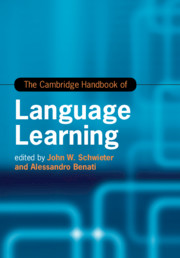Book contents
- The Cambridge Handbook of Language Learning
- Cambridge Handbooks in Language and Linguistics
- The Cambridge Handbook of Language Learning
- Copyright page
- Contents
- Figures
- Tables
- Contributors
- Acknowledgements
- Introduction
- Part I Theories
- Part II Methods
- Part III Skill Development
- Part IV Individual Differences
- 15 Working Memory in L2 Learning and Processing
- 16 Language Aptitudes in L2 Acquisition
- 17 Language Learner Motivation: What Motivates Motivation Researchers?
- 18 A New Look at “Age”: Young and Old L2 Learners
- 19 Identity
- Part V Pedagogical Interventions and Approaches
- Part VI Context and Environment
- Part VII Moving Forward
- Index
- References
17 - Language Learner Motivation: What Motivates Motivation Researchers?
from Part IV - Individual Differences
Published online by Cambridge University Press: 25 June 2019
- The Cambridge Handbook of Language Learning
- Cambridge Handbooks in Language and Linguistics
- The Cambridge Handbook of Language Learning
- Copyright page
- Contents
- Figures
- Tables
- Contributors
- Acknowledgements
- Introduction
- Part I Theories
- Part II Methods
- Part III Skill Development
- Part IV Individual Differences
- 15 Working Memory in L2 Learning and Processing
- 16 Language Aptitudes in L2 Acquisition
- 17 Language Learner Motivation: What Motivates Motivation Researchers?
- 18 A New Look at “Age”: Young and Old L2 Learners
- 19 Identity
- Part V Pedagogical Interventions and Approaches
- Part VI Context and Environment
- Part VII Moving Forward
- Index
- References
Summary
Second language (L2) motivation as a field of research has expanded rapidly in recent years, attracting scholars from increasingly diverse educational contexts and theoretical perspectives. The move towards more learner-centred approaches in language education, together with an accompanying interest in the various contributions learners make to their own learning, pushed the study of motivation into a prominent position on the current research agenda. From a field consisting of a small group of researchers and a handful of infrequent articles in the 1980s, L2 motivation research has thrived (Boo, Dörnyei, & Ryan, 2015), with articles frequently appearing in leading journals and the field even meriting its own handbook (Lamb et al., forthcoming). Motivation, uniquely among the so-called language learner individual differences, has been enthusiastically embraced by both researchers and classroom practitioners, resulting in a fast-changing and rapidly expanding theoretical landscape.
- Type
- Chapter
- Information
- The Cambridge Handbook of Language Learning , pp. 409 - 429Publisher: Cambridge University PressPrint publication year: 2019
References
- 2
- Cited by

